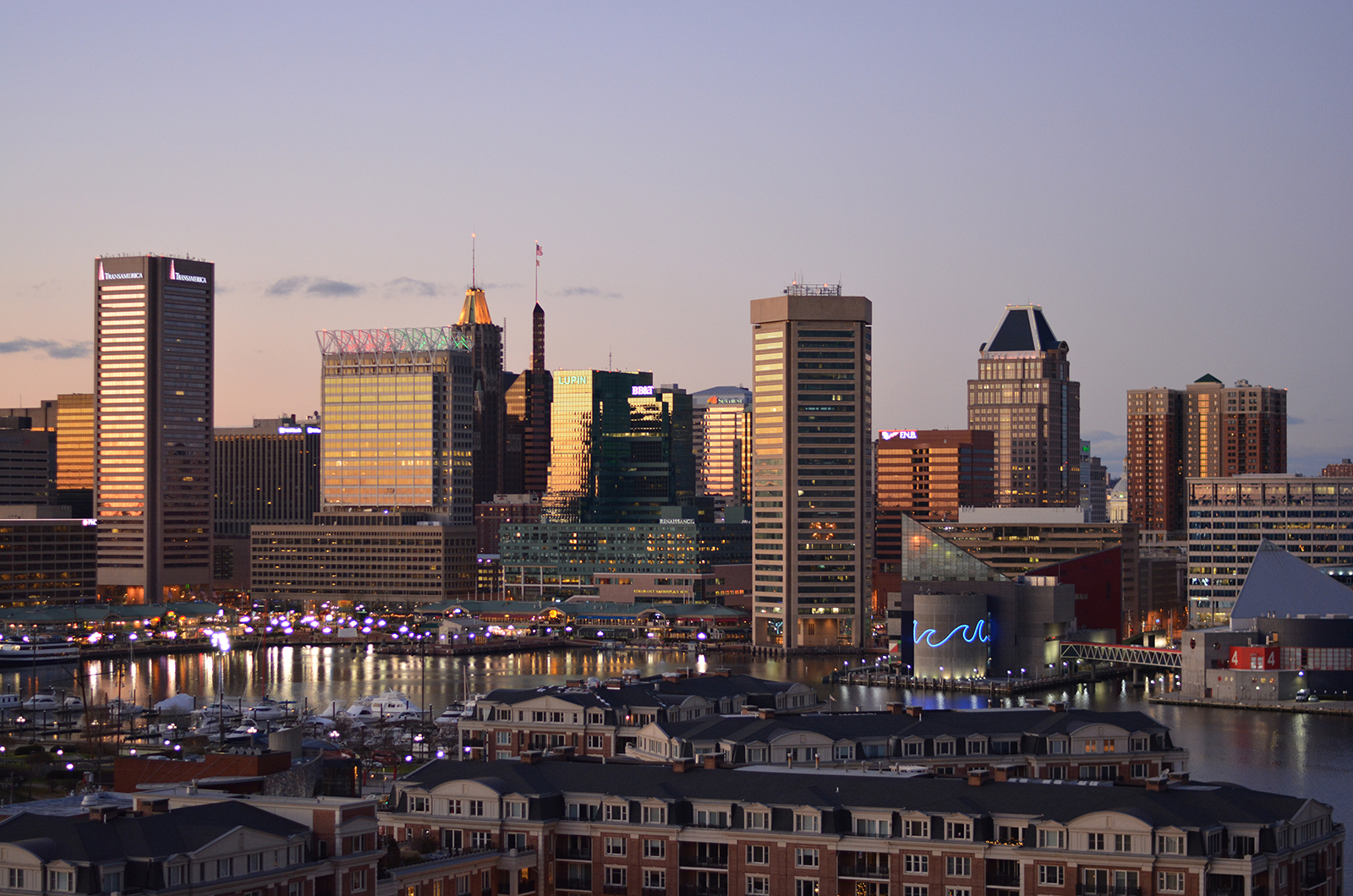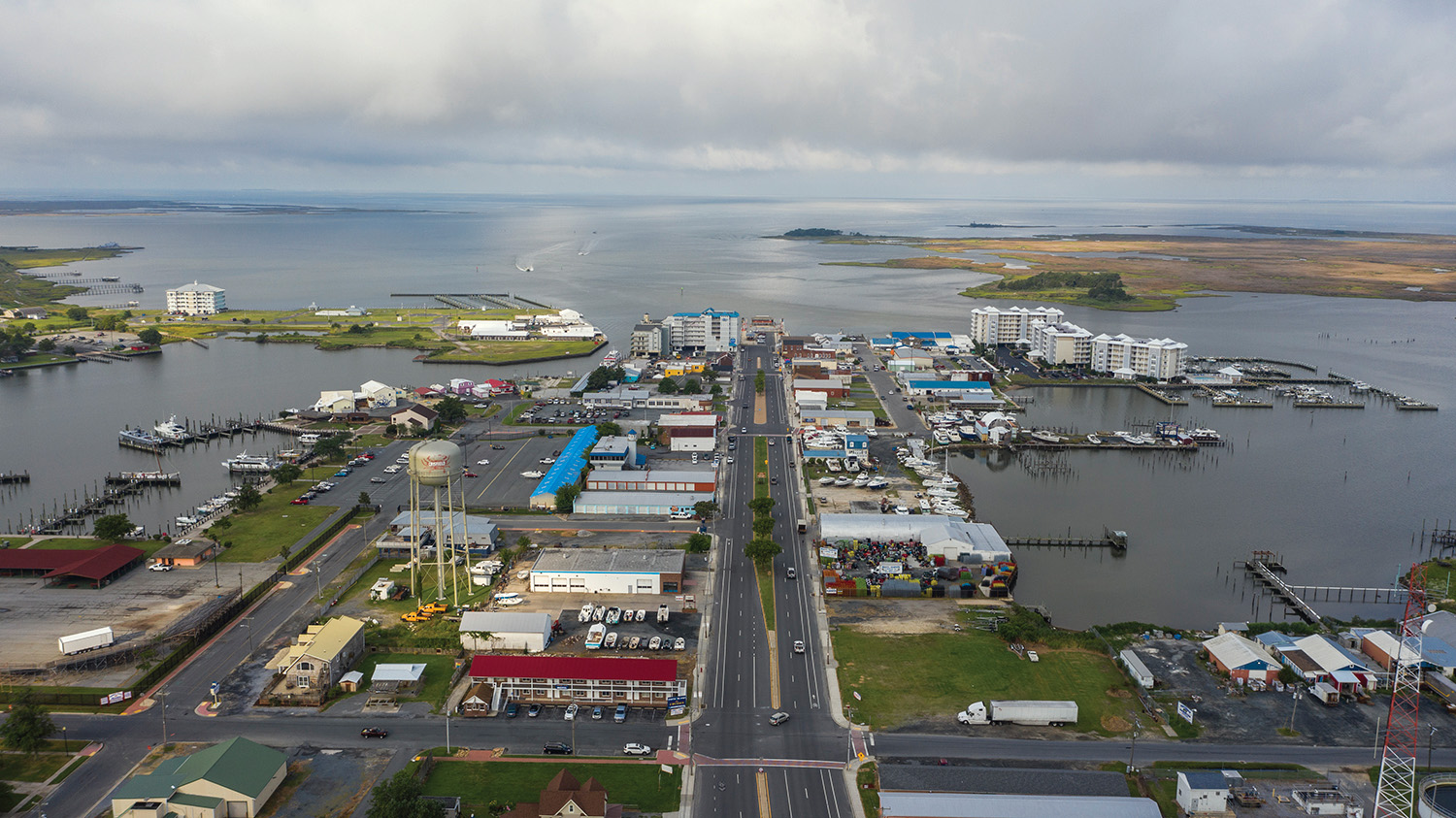
Washington, D.C. Kristof Grina, Co-founder and Director of Agriculture of Up Top Acres, harvests vegetables from a rooftop garden covering a third of an acre in southeast Washington, D.C. © Greg Kahn
From east to west, Maryland’s urban centers are as diverse as the landscapes in which they sit. Located within what has been termed the Northeast megalopolis, or the Boston-Washington corridor, cities are an essential part of Maryland’s identity. Making city centers greener and more livable can have outsized conservation benefits, such as helping to reduce urban sprawl and habitat conversion, reducing transportation emissions, and improving water quality in local waterways and downstream.
The challenge is that many cities in our region struggle with inadequate and aging infrastructure, pollution, short-sighted development, and legacy injustices from a history of segregation and discriminatory housing and development practices. These factors worsen air and water pollution, heat and flooding, and contribute to human health and biodiversity problems. The Nature Conservancy’s mission to conserve the lands and waters on which all life depends includes addressing the conservation needs of people living urban areas in Maryland and the District of Columbia.

City Spotlight
Washington, D.C.
Since 2014, TNC has been a key participant and partner in the DC City Government's Stormwater Retention Credit (SRC) market. The SRC market offers real estate developers an alternative way to offset their stormwater management requirements by purchasing credits that are generated by the contruction of offste green infrastructure projects - projects like the ones TNC has been building across the city. These projects provide a suite of nature-based, community benefits such sa water quality improvements, reduced flooding, reduced summer heat, and expanded access to green space.
Cities around the world are looking at DC as a model and many are now taking steps toward implementing similar market-based approaches to tackling their stormwater problems.

Stormwater: Growing Problem, Natural Solutions
Stormwater pollution is caused when rainwater falls on impervious surfaces—including sidewalks, parking lots and roads—where it mixes with oil, sediment, trash and other pollutants. It then flows into our cities’ sewer systems and rivers.
Replacing, buffering or retrofitting impervious surfaces with water retaining green infrastructure like rain gardens allows polluted stormwater to be captured and cleaned. Water is absorbed and filtered by the plants, topsoil, sand and gravel layered within a rain garden.

Mount Olivet Cemetery
A partnership between Mount Olivet Cemetery, The Nature Conservancy (TNC) and other local non-profits began in 2017 when TNC met with Mount Olivet to discuss the cemetery’s vision for the future of its grounds.
TNC led a project to replace more than 44,000 square feet of impervious surface with rain gardens, pollinator gardens and other forms of green infrastructure that reduce the cemetery’s water bill, improve water quality for the nearby Anacostia River and generate stormwater retention credits that TNC sells on the D.C. Stormwater Credit Trading market. Profits are reinvested into conservation.

Knollwood Lifeplan Community
A large, three-phase green stormwater infrastructure project at Mt. Olivet Cemetery was TNC's first successful foray into Washington, DC’s innovative stormwater retention credit market, implemented through its subsidiary, District Stormwater LLC. In summer 2021, we celebrated the completion of another stormwater project.
Through District Stormwater LLC, TNC and the Knollwood Life Plan Community collaborated on a green infrastructure site and rain garden. Located in northwest Washington, the Knollwood property sits directly next to Rock Creek Park, one of the city’s most beloved natural landmarks.
The garden collects stormwater runoff from the facility’s parking lots—an estimated 3 million gallons annually—to help slow and clean the runoff before it flows into Rock Creek and ultimately into the Potomac River and Chesapeake Bay. The project also generates SRCs to be sold on DC's Stormwater Retention Credit market.
The Knollwood community is home to some 300 residents, most of whom are retired military personnel and their families. Its proximity to Rock Creek Park with its miles of hiking trails is certainly one of the neighborhood’s biggest draws, and through this stormwater project, Knollwood is doing its part to help improve the health of Rock Creek.
Quote: Jeanne Braha
As climate change increases heavy precipitation events, we all must be more creative. Thank goodness for smart incentives to drive effective partnerships like this one.
Smart Ponds
One of the oldest methods for capturing runoff, the stormwater pond, is getting a digital makeover. No longer simply collecting rainfall washing off pavement and lawns, smart ponds anticipate precipitation before it begins and adjusts to reduce downstream pollution and flooding.
In a program that could serve as a national model of environmental stewardship, TNC is partnering with the Maryland Department of Transportation (MDOT), the Maryland Department of the Environment (MDE) and technology firm Opti to implement advanced stormwater control technology at existing sites to help curb local flooding and reduce stormwater runoff to the bay.
Smart pond technology uses sensors and software to monitor real-time conditions such as water level and storage volume. The system uses internet-based forecasts to remotely operate valves that control timing and volume of water discharge. Longer retention time increases water quality by capturing more sediment and nutrients. When rain is forecast, the system can automatically open valves to drain the pond prior to precipitation. This helps maximize storage efficiency and can reduce downstream flooding.
Working together to harness technologies that deliver low-cost solutions to water pollution, our hope is that this innovative approach can be replicated across the bay watershed and beyond.

City Spotlight
Baltimore
Thanks to a grant from the France-Merrick Foundation, in 2020 TNC expanded our Build Green Cities program to Baltimore with the goal of weaving our mission into the fabric of this vibrant community.
Baltimore is one of the most densely populated coastal cities in America. Residents’ lives are heavily impacted by heat waves and flooding, both of which are exacerbated by climate change. TNC's conservation focus is centered on on-the-ground community-driven conservation projects with an emphasis on stormwater retention and coastal resilience, strategic tree canopy expansion and environmental justice initiatives emphasizing youth engagement.

Turner Station: A Case Study in Community Engagement
Established in the 1880s, Turner Station boasts a rich history and remains one of the largest African American communities in Baltimore. Today, residents are working to implement projects that address climate change, which disproportionately impacts the community of Turner Station because of its long history of environmental injustices.
Two years ago, TNC partnered with Turner Station on an initiative called “Witness Trees,” a project that elevates Turner Station’s cultural heritage through art and tree plantings. This past year, the Baltimore team commenced a series of tree planting design workshops with youth from the Turner Station community. In collaboration with artist Saba Hamidi and partner EnviroCollab, TNC worked with Boy and Girl Scout troops to design a public art installation, paired with a tree planting, to capture the youth’s collective vision for their neighborhood.
Thanks to our investment in community engagement and urban forestry, TNC has supported the successful planting of 140 trees in Turner Station—with more to come. This type of community engagement work is highlighting the importance of equitable access to nature and supports our goal of helping 500,000 Maryland and DC residents on the front lines of climate impacts by 2030.
To The Jungles That Be
In the new animated short film To The Jungles That Be, the work of Baltimore poet Kondwani Fidel and artist Saba Hamidi highlight how people experience nature differently depending on where they grow up and whether they have access to healthy natural environments. The film is being used to start conversations in urban and underserved communities to better understand their relationship to nature and their interest in participating in Maryland’s Tree Solutions Now Act, which aims to plant 5 million trees in the state by 2031 with 500,000 in urban and underserved communities.
The film can be viewed on The Nature Conservancy’s Youtube channel or www.tothejungles.com, where users are also invited share their stories and experiences of nature.

Sediment Banking
[PLACEHOLDER]
Environmental Justice
As we build relationships in Baltimore, it’s important that we understand the injustices that exist today and the history of systemic racism, segregation and discriminatory housing and urban planning practices that led to them. The lasting impacts of these legacy racist policies—including redlining—have created neighborhoods that lack access to green spaces and trees.
Communities and organizations in Baltimore are facing these challenges head on, demonstrating that the city’s past doesn’t have to dictate its future. With innovative city programming, community organizing and public–private partnerships, Baltimore is in the midst of the type of transformative change needed in cities across the country.
As we deploy on-the-ground projects in Baltimore, we are committed to applying an equity and justice lens to everything we do. As an organization that works both globally and locally, we bring solutions and lessons that have been tested in other cities. We also bring pre-existing relationships with government agencies and state officials that can accelerate the pace and scale of conservation in Baltimore. We envision a future where Charm City is America’s most resilient city.

City Spotlight
Crisfield
The coastal town of Crisfield, Maryland, home to almost 2,500 residents, is known for its rich history in the seafood industry. Crisfield is one of many coastal Maryland towns grappling with increased flooding that threatens infrastructure and disrupts daily life. In Crisfield, flooding often occurs even on sunny days and can force students to miss school and businesses to close their doors.
Maryland’s lower Eastern Shore is one of the most vulnerable areas to sea-level rise, with underserved communities like Crisfield now sitting on the front lines of climate change. While funding exists to help underserved communities increase their resilience to climate change, many of them face barriers to accessing available resources.
Since 2022, TNC has partnered with the Crisfield community to provide technical support and grassroots resilience planning for several flood adaptation projects. Thanks to these efforts, Crisfield was recently awarded a $36 million grant from the Federal Emergency Management Agency (FEMA) called the Building Resilient Infrastructure and Communities (BRIC) grant, which will be used to fix broken infrastructure and begin to move new infrastructure to higher ground. TNC and other NGOs and government agencies are now using Crisfield as a model for community-led resilience planning in other low-lying Maryland communities.

SEAFARE Improves Access to Climate Funding
Maryland is experiencing one of the highest rates of sea-level rise in the country, but the most heavily impacted coastal communities in Maryland have not received climate adaptation and flood mitigation funding at the scale required to effectively improve resilience along its more than 7,700 miles of shoreline. Sea-level rise and other impacts of climate change disproportionately impact coastal communities—especially communities that have been historically underserved and overburdened—which are frequently also communities of color. These communities have the greatest hurdles to overcome to access climate adaptation funding, which includes complicated legislative frameworks, complex and alienating solicitation language and restrictive funding criteria. This results in climate adaptation programs that perpetuate and even exacerbate inequities.
The Supporting Equitable Access to Funding for Adaptation Resources—or SEAFARE—is the result of a series of workshops conducted by the Maryland/DC Chapter with climate adaptation practitioners, environmental justice leaders, non-profit partners, residents of coastal Maryland and state and federal officials to identify those barriers and create a toolkit with recommendations for decision-makers on ways to improve these funding systems. Check out our storymap and report to learn more.
Contact
Aileen Craig, PE
Chesapeake Stormwater Program Director
email: aileen.craig@tnc.org
Isaac Hametz
Baltimore Program Director
email: isaac.hametz@tnc.org
Our Cities Work
North America Cities Network
Cities are home to more than 62% of the U.S. population. To fulfill our mission, The Nature Conservancy must address the conservation needs of these areas.

We Can’t Save Nature Without You
Sign up to receive monthly conservation news and updates from Maryland/DC. Get a preview of Maryland/DC's Nature News email.





